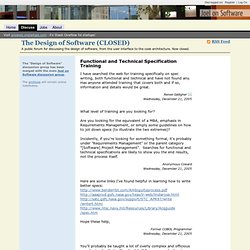

The Design of Software - Functional and Technical Specification Training. Regardless of whether you do "agile" requirements engineering or not, you'll need to learn how to write "good" requirements.

The reasons we use "overly complex and officious mumbo jumbo" are the same as why we use languages like C# or Java or VB or whatever to write code. When you have some structure to your requirements, you'll begin to see patterns evolve. This makes it easier to write similar requirements more clearly. Structure also makes it easier to inspect the requirements since you can train your eyes to easily spot a "wrong" requirement ( You could even write a parser to automate some of the inspection process, looking for ambiguous words and weak phrases. Personally I don't care if you write use cases, user stories, functional requirements or foo bars, just write them so that they are complete, precise, verifiable, distinct, unique, and traceable.
Painless Functional Specifications - Part 1: Why Bother? By Joel Spolsky Monday, October 02, 2000 When The Joel Test first appeared, one of the biggest sore points readers reported had to do with writing specs.

It seems that specs are like flossing: everybody knows they should be writing them, but nobody does. Why won't people write specs? People claim that it's because they're saving time by skipping the spec-writing phase. Functional Spec Tutorial.